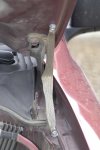taugust
Adventurer
Another thread asked about mounting an HF radio in a vehicle. After typing all of this out, I realized it was a hijack, so I thought I would start a new thread. By no means is this a definitive resource, but it gives some basics that I learned recently and my help others. Be aware that DC ground and RF ground are completely different and one does not subtitute for the other.
I found that proper grounding of the antenna mount and "bonding" of the body panels is critical to getting a decent SWR on mobile HF. This is true even if using the ATAS-120. When I first installed the HF antenna mount, I couldn't get a decent SWR at all. I thought that screwing into the fender would be sufficient. Not. Many of the body panels are isolated from each other. So after some reading about grounding on the internet, I bought some tinned copper braided strap and terminal lugs and began connecting everything together. A mobile vertical antenna is one half of a dipole, with the other half supplied by the body of the vehicle. The more of the vehicle you use, the better your reception and transmissions will be. You want to connect as many body panels to the frame as possible. If you can't go directly to the frame, connect to another panel which is connect to the frame.
The strap is a low impedence connection and is much better than stranded wire. The wider the better, and keep length to less than 2 feet. The stuff can be expensive, but I found that my local electronics shop had some old narrower stock that was 55 cents per foot. The newer, wider stuff was $2- $3 per foot. I bought 15 feet of the cheaper stuff.
I started with strapping the mount to the frame and connecting the hood to the cab at both of the hinges. This alone actually brought my SWR into usable range for some bands.
Then I slowly added more. I currently have about 11 straps throughout the vehicle, and I am still not done: Antenna mount (left fender) to frame, 2 from hood to cab, transmission to frame, 2 from cab to frame, 4 from bed to frame (4 corners), exhaust pipe to frame. I still need more on the exhaust pipe and the body panels in some places, as well as several from engine to frame. The engine and exhaust are apparently large sources of ignition noise, so grounding these in several places will greatly reduce to noise on your signal. I still have about 6 feet of strap left.
The literature I read says to both crimp and solder the terminals to the braid, and to use star washers to bite into the metal for a good connection. I used self drilling screws.
I found that proper grounding of the antenna mount and "bonding" of the body panels is critical to getting a decent SWR on mobile HF. This is true even if using the ATAS-120. When I first installed the HF antenna mount, I couldn't get a decent SWR at all. I thought that screwing into the fender would be sufficient. Not. Many of the body panels are isolated from each other. So after some reading about grounding on the internet, I bought some tinned copper braided strap and terminal lugs and began connecting everything together. A mobile vertical antenna is one half of a dipole, with the other half supplied by the body of the vehicle. The more of the vehicle you use, the better your reception and transmissions will be. You want to connect as many body panels to the frame as possible. If you can't go directly to the frame, connect to another panel which is connect to the frame.
The strap is a low impedence connection and is much better than stranded wire. The wider the better, and keep length to less than 2 feet. The stuff can be expensive, but I found that my local electronics shop had some old narrower stock that was 55 cents per foot. The newer, wider stuff was $2- $3 per foot. I bought 15 feet of the cheaper stuff.
I started with strapping the mount to the frame and connecting the hood to the cab at both of the hinges. This alone actually brought my SWR into usable range for some bands.
Then I slowly added more. I currently have about 11 straps throughout the vehicle, and I am still not done: Antenna mount (left fender) to frame, 2 from hood to cab, transmission to frame, 2 from cab to frame, 4 from bed to frame (4 corners), exhaust pipe to frame. I still need more on the exhaust pipe and the body panels in some places, as well as several from engine to frame. The engine and exhaust are apparently large sources of ignition noise, so grounding these in several places will greatly reduce to noise on your signal. I still have about 6 feet of strap left.
The literature I read says to both crimp and solder the terminals to the braid, and to use star washers to bite into the metal for a good connection. I used self drilling screws.


